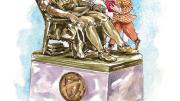1912
The Harvard Dental School announces plans to open an evening clinic, staffed by graduates, with nominal fees of 25 cents or less.
1917
With the country at war, Harvard’s Committee on Military Affairs advises alumni and undergraduates: “Rather than enlist as a private, try to qualify as an officer…or as a specialist.” Universities, notes the Bulletin, are best qualified to provide men with special training “above the ears.”
1927
The Faculty of Arts and Sciences implements a new academic schedule with two lecture-free “reading periods”—a reform intended to free students “from a minute and continuous supervision of their studies” and to relieve teachers “from part of their excessive burden of teaching.”
1947
Harvard students boycott a local tavern that has refused to serve several black undergraduates; a University-wide Committee on Discrimination is set up.
1952
The editors bemoan the fading popularity of formal dress, as evidenced by the ascendancy of the ready-made suit over the tailored and sartorial fads like string ties, six-foot mufflers, elbow patches, and white shoes.
1957
FAS dean McGeorge Bundy expresses hope that the Program for Harvard College will raise enough money to let Harvard set an instructor’s starting salary at $6,000 and a professor’s top salary at about four times that amount.
1992
As part of its campaign for increased faculty diversity at the school, the Law School Coalition for Civil Rights organizes two sit-ins at faculty offices and criticizes approval of tenure offers to four white male professors.
2002
The first Women’s Guide to Harvard is published, featuring everything from a directory of female faculty to information on gynecological exams.
2007
Radcliffe Institute dean Drew Gilpin Faust is named the twenty-eighth president.
An FAS task force asks professors to embrace a “compact” to enhance teaching and learning, and to consider those responsibilities as equal in importance to excellence in scholarship and research.








